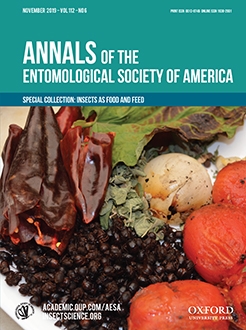The black soldier fly, Hermetia illucens (L.), is economically important due to its use in waste management and as an alternative protein source for livestock, poultry, and aquaculture. While industry promotes mass production of the black soldier fly, little is known about the impact of larval competition on development time, resulting immature and adult weight, or adult longevity. The goal of this research was to examine the life-history traits of black soldier flies when reared at four densities (500, 1,000, 1,500, and 2,000 larvae/4-liter container) provided 54-g Gainesville diet at 70% moisture (feed rates of 0.027, 0.036, 0.054, and 0.108 g) every other day. Results were as expected with the lowest larval density (500) producing heavier individuals (by 26%) than the greatest larval density (2,000) across all life stages. In addition to weights, larvae reared at the lowest density developed 63% faster than those reared at the greatest density. In regard to pupal development time, those reared at the lowest larval density developed 3% slower than the greatest density. A 21% difference between the two extreme densities was found in survivorship to prepupal stage, with the lowest larval density having the greatest survivorship (92%) compared with the greatest larval density (70%). All densities displayed over 90% adult emergence rates. Such information is vital for optimization of the process of converting waste products to protein at an industrial scale with the black soldier fly.
How to translate text using browser tools
11 September 2019
Impact of Larval Competition on Life-History Traits of the Black Soldier Fly (Diptera: Stratiomyidae)
Brittny M. Jones,
Jeffery K. Tomberlin
ACCESS THE FULL ARTICLE
It is not available for individual sale.
This article is only available to subscribers.
It is not available for individual sale.
It is not available for individual sale.
intraspecific competition
longevity
population density





